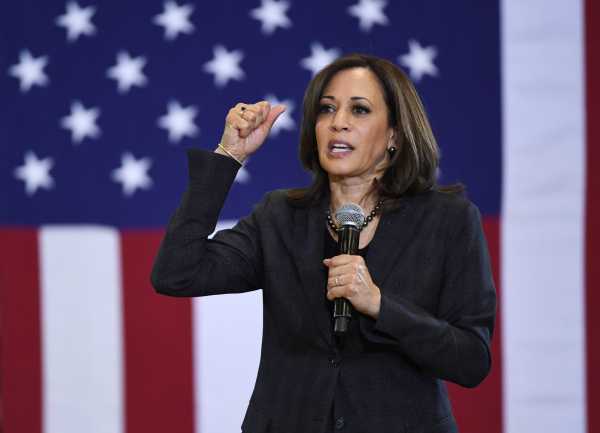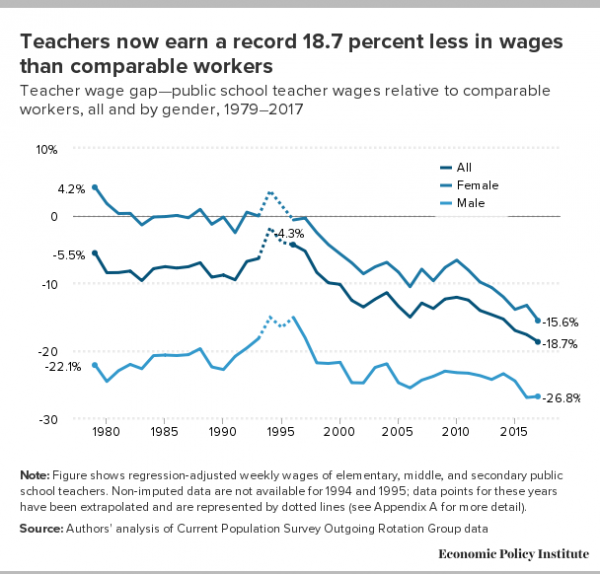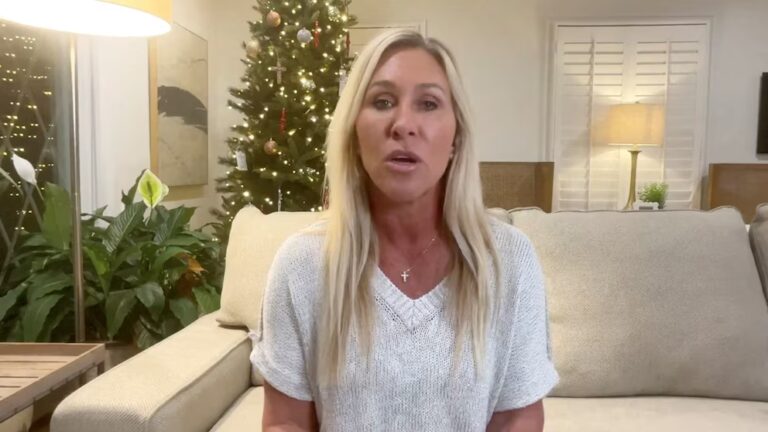
Sen. Kamala Harris (D-CA) has the first major K-12 education proposal of the Democratic presidential primary so far: giving American teachers a significant raise.
The California senator is proposing the federal government spend $315 billion to increase teacher salaries over the next 10 years. Through a combination of direct federal spending and matching funds from states, the goal is to give the average US teacher a $13,500 pay increase in her first term, paid for by hiking taxes on wealthy estates. The average teacher salary is currently about $60,000, though there is considerable variation across states.
Education is rarely a major issue during presidential campaigns. But Harris’s plan could tap into a wave of energy and enthusiasm from teachers strikes around the country in the past two years, most recently in Los Angeles and Denver but also in traditionally red states, such as West Virginia, Oklahoma, and Arizona.
Those strikes have attracted public sympathy as well as solidarity from Harris and her fellow 2020 contenders. Two-thirds of Americans support teachers’ right to strike for better pay and benefits, according to a recent USA Today/Ipsos poll, and six in 10 believe teachers are not compensated fairly.
“We are a nation and a society that pretends to care about education. But not so much the education of other people’s children. We gotta deal with that,” Harris said Saturday, previewing her plan. “You can judge a society by the way it treats its children. And one of the greatest expressions of love that a society can give its children is educating those children with the resources they need. Teachers are our greatest resource in that endeavor.”
Harris’s plan could provide a sharp contrast to the state-level Republican agenda, as experts say state Republican leaders’ focus on cutting taxes has often come at the expense of teacher salaries. But it would also require the states themselves to buy in for the plan to succeed — and states aren’t always willing to sign up for an initiative that requires them to spend money, even with a generous match from the federal government.
More immediately, in the Democratic primary, Harris’s plan could appeal to the teachers unions that have long been major players in Democratic politics — with an issue that’s been a major motivator for them in the past few years.
How Kamala Harris wants to raise teacher salaries
The Harris plan starts with a specific goal: giving the average teacher a $13,500 raise over four years, which her campaign says would close the gap in what US teachers currently make compared to other professionals with similar education and experience.
The Education Department would work with state education agencies, which provide the bulk of the funding to the local districts that run America’s public schools, to set some localized standards for how much beginner teachers should be paid, and then increase compensation based on time of service and other qualifications.
In the first year, the federal government would provide 10 percent of the funding for the pay raises directly to states. States would be required to use the federal dollars on teachers compensation, rather than to replace their existing K-12 funding. In the second, third, and fourth years of the plan, states would be required to chip in, but they would still receive a generous federal match — for every $1 that a state spends to increase teacher salaries, the feds would kick in $3.
So Harris’s proposal would require states to buy in — and contribute money — to realize its full potential. Her campaign says it is optimistic that the terms of the deal and the overwhelming public support for teachers, as demonstrated by the recent strikes in red states, would lead to states electing to participate in the program. A Harris aide noted that GOP governors and legislatures in Arizona and Oklahoma recently approved pay increases for teachers on their own. Still, considering the recent example of Medicaid expansion under the Affordable Care Act, it can’t be taken as a given that Republican-led states would willingly join a major Democratic initiative, even a popular one.
Harris says her plan would also invest in teachers in high-need schools and in teacher development programs, though she hasn’t yet provided details.
The estimated cost of the proposal is $315 billion over 10 years, according to Harris’s campaign. Harris would target estate taxes to pay for the plan: According to a campaign aide, that could include lowering the amount of an inheritance that is exempted from the estate tax (that exemption was doubled by the Republican tax law to $11 million), making the estate tax more progressive, and closing loopholes (one frequently flagged example is the use of trusts to transfer wealth and avoid the tax).
“Raising teacher pay is one pillar in a strategy to bring working people who are the backbone of our economy out of the margins and into the center of the conversation about economic justice,” Harris’s campaign said.
Teacher pay has been stagnating for decades
Teacher pay is stagnating and has been for years. Adjusted for inflation, teachers are actually being paid $27 less per week than they were in 1996, as the left-leaning Economic Policy Institute has documented. The average US teacher salary is a little less than $60,000 — less than other workers who have bachelor’s or master’s degrees — but compensation varies significantly from place to place. In New York state, the average pay for teachers is nearly $80,000; in Oklahoma, it’s less than $40,000.
Teacher wages have fallen substantially when held up against other comparable workers with college degrees as well. Women especially used to earn a premium salary as teachers in the 1970s, but they now face a serious economic disadvantage versus other professions.

Even accounting for improved benefits for teachers, they are still receiving 11 percent less in compensation than their peers in other fields, according to the institute’s analysis.
These stagnating wages, particularly in recent years, can be directly blamed on Republican-led states prioritizing tax cuts over K-12 education spending. From EPI:
The Equity Project, a charter school in New York City, has seen significant student achievement gains under a model that, among other policies, sets teacher salaries at $125,000, twice what teachers in the public schools system would make on average.
As the Economic Policy Institute put it: “If the policy goal is to improve the quality of the entire teaching workforce, then raising the level of teacher compensation, including wages, is critical to recruiting and retaining higher-quality teachers.”
Democrats are still figuring out their education agenda
Harris is targeting a core Democratic constituency with her proposal. Teachers unions have always been stalwart supporters of the party, and their support would be a valuable asset in a Democratic primary. The plan has been praised already by Randi Weingarten, president of the American Federation of Teachers.
But the plan also reflects the changing winds on education policy on the left. Democratic Party leaders and unions had found themselves at odds over the past decade, as President Barack Obama and other Democratic leaders embraced charter schools and tying teacher pay to test scores. Those trends have started changing considerably in the past few years.
In Boston, a majority-Democratic city where the evidence seemed to clearly show that charter schools had improved education, voters summarily rejected a 2016 ballot initiative to expand them. In Los Angeles, teachers went on strike, pushing back against charter school expansions, with support from presidential hopefuls including Harris and Sen. Bernie Sanders (I-VT).
Teachers there, in West Virginia, and elsewhere have walked out of the classroom while demanding better pay, protesting recent cuts to insurance benefits, and warning about an unreasonable expansion of their class sizes. Policymakers have capitulated to the teachers with small pay increases and other concessions.
Democrats these days don’t have a lot of enthusiasm for challenging teachers unions, and they’ve started to abandon the Obama-era centrist consensus. Support for charter schools among Democratic voters has dropped from nearly 50 percent earlier this decade to just 36 percent now, according to an Education Next survey. Meanwhile, 75 percent of Democrats said they support national teachers unions in the recent Ipsos poll.
“I think the reform community both declared victory and got sick of the argument,” Andy Rotherham, who worked on education policy under President Bill Clinton, told me recently.
That has left a void in the Democratic platform: If not charter schools and standardized tests and corporate-style accountability, then what? Harris’s new plan to raise teacher pay charts a new path forward, one that aligns with the party’s leftward drift on health care, climate change, and other issues: investing substantially more public money to fix problems.
Sourse: vox.com






